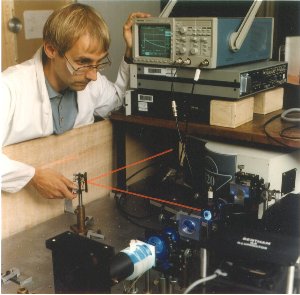Research
Department of Chemistry, University of Durham
Prof. Andy Beeby, Research Interests
My research interests lie in the fields of photochemistry and photophysics. This work encompasses a wide range of related topics, including the determination of fundamental photophysical parameters, the identification of intermediate species and their kinetic behaviour and the characterisation of a reactions end-products. It is only by having a detailed understanding of all these factors that we can design chemical systems in which we have control over the direction and outcome of photochemical reactions. This comprehensive approach is applied to
the study of a number of photo-induced reactions, such as energy transfer, electron transfer and isomerisation. These processes are studied in a range of chemical systems including commercially important materials, e.g. pharmaceuticals & electroluminescent materials, compounds of fundamental interest, e.g. those that show twisted intramolecular charge transfer (TICT) states, and new materials such as C60 and electroluminescent materials.
The group is well equipped to carry out these measurements – see equipment/experimental facilites. We always welcome enquiries from groups that would like to collaborate on any measurements.
Current research programmes include;
Luminescence spectroscopy and Imaging I am interested in the phenomenon of luminescence and I’ll look at pretty much anything that glows! We have a wide range of excitation sources and detection systems allowing us to look at all types of sample, under a wide range of conditions. I am particularly interested in emission in the NIR spectral region: 700 – 1700nm, and we are one of the few groups in the UK able to record emission lifetimes and spectra in this region. Our expertise also extends to luminescence imaging using both single and two-photon excitation, and steady-state and time-gated modes.
Raman Spectroscopy for the Analysis of Pigments in Medieval Manuscripts. Something completely different – I have been using Raman spectroscopy and optical absorption measurements to analyse the pigments found in illuminated manuscripts. These non-invasive techniques provide an insight into the materials used by scribes in the 7-11th centuries and our work helps to show the transfer of writing technology through this period. See our blog.
Studies of Phthalocyanines Our group carries out fundamental research into the photochemical properties of phthalocyanines, a class of compound that that has a wide range of applications including photodynamic therapy, PDT. Our work is currently focussing on the synthesis and characterisation of luminescent dimeric phthalocyanines with interesting properties, the protonation of phthalocyanines and the preparation of electron-donor phthalocyanine dyads.
Sensitisation of Lanthanide Luminescence. We have investigated the fundamental photophysical properties of lanthanide ions, including an understanding of the pathways of energy transfer from organic chromophores to the metal ions. Although the properties of terbium and europium have been extensively studied the photophysical behaviour of many other luminescent lanthanide ions in solution have been somewhat neglected for various reasons. We are investigating systems based upon neodymium, ytterbium and erbium in aqueous media and have observed interesting isotope and ligand effects. This work is technically challenging due to the fact that the emission is short lived and in the near infra-red spectral region.
Electroluminescent Materials. In the near future it is expected that conventional displays, based upon cathode-ray tubes, will be replaced by new technologies utilising thin-film electroluminecent materials. Devices based upon organic materials rely upon the recombination of holes and electrons that are injected into the material producing excited states, known as excitons, which can be either triplet or singlet character. In conventional materials based upon conjugated polymers only the singlet state excitons can emit light, and triplet excitons, are effectively wasted energy. Our interest lies in the use of organometallic complexes that are capable of harvesting both singlet and triplet excitons to produce light output and includes both the synthesis of new materials and the study of their spectroscopic properties. Using our understanding of the electronic structure of these materials and how it controls the emission behaviour we can also develop new molecular probes based upon this class of material.
Oligoarylethynylenes These highly luminescent compounds are currently the subject of intense attention as potential ‘molecular wires and switches’ and as emissive layers for organic LED’s. In collaboration with colleagues at Durham we have been studying the effects of conformation upon the emission and material properties of the compounds.
The Photochemistry of Sunscreens. A study of the photochemical activity of a number of commercially used UV-A and UV-B absorbers, with particular emphasis upon the intermediate states formed upon excitation and their deactivation pathways. This work has included studies of enolised 1,3-diketones, e.g. Parsol-1789, and anthranilate esters. The latter have been shown to be potent sensitisers of singlet oxygen in solution.
Students – Past and Present (date of completion)
Dr Claire Stanley (1997)
Dr Catherine Coultous (1999)
Dr Allison Wigman (1999)
Dr Ian Clarkson (1999)
Dr Allison Jones (2000)
Dr Lisa Bushby (2001)
Dr Simon FitzGerald (2002)
Dr Sylvia Bettington (2003)
Dr Karen Findlay (2007)
Dr Simon Rutter (2007)
Dr Lucas Applegarth (2010)
Dr Ben Coombs (2010)
Dr Robert Edkins (2012)
Miss G. A Rosser
Miss V. Manici
Mr Andrew Duckworth
Publications
For some recent publications please click here.

Return to the Durham Chemistry Home page
This page last modified by AB 1st Sept. 2013
